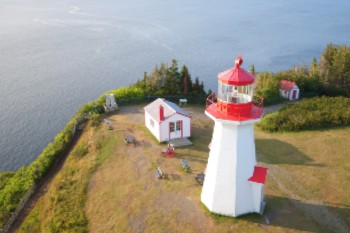
A heritage building had to be relocated at Forillon
Forillon National Park

The team at Forillon National Park successfully relocated the cannon shelter at the Cape Gaspé lighthouse station, as it was threatened by shoreline erosion. By doing so, Parks Canada took preventative measures to ensure the protection of the heritage building, which was situated just 2.8 m from the edge of the highly eroded cliff.
Built in 1883, the fragile wooden structure, measuring approximately 12 by 16 feet, was therefore cautiously relocated by a few metres on October 10th, 2019. It is the first heritage building to be relocated in Forillon National Park.
Several elements were considered when selecting the building’s new location, including its original location and orientation (a testimony to its original purpose in direct connection with Gaspé Bay/Gulf of St. Lawrence), its integration with other built elements at the station (lighthouse and fog alarm building), the impact on the cultural landscape, the quality of visitor experience on site, and the building’s potential for enhancements.
This relocation will ensure the conservation of the cannon shelter over the long term. It will also promote its enhancement by offering a new purpose, allowing visitors to enjoy it more fully and to better understand its importance within the history of the lighthouse station.

The erosion issue at Forillon National Park
Climate change causes an acceleration of the phenomenon of shoreline erosion. At Forillon National Park, the average shoreline recession shifted from approximately 2 cm/year (before the mid 1990s) to nearly 20 cm/year in recent years.
Parks Canada has already carried out several projects to adapt to this new reality at Forillon National Park, including restoration projects for the Penouille and Cap-des-Rosiers shoreline dynamic.
The historical importance of the cannon shelter

The construction of the cannon shelter 1883 marked the introduction of the cannon as the station’s sound signal. In 1894, the cannon was replaced by explosive guncotton cartridges; the cannon shelter’s roof would then serve as a support system for the metallic structure which launched the cartridges (a structure that no longer exists today).
This building is important to the site’s history, as it is the only remaining construction from the first lighthouse era. It is unique, and is also the only and last remaining witness to the modernization of buildings and the evolution of navigation techniques and equipment in the late 19th century.
A spectacular landscape
The Cape Gaspé lighthouse station can be accessed by the 4 km Les Graves wooded trail intended for hikers and cyclists. Perched above a cape over 90 metres high, it offers spectacular views over the Gulf of St. Lawrence, Gaspé Bay, the shoreline between Gaspé and Percé, and the emblematic Percé Rock.
Since access to the site is forbidden to cars, it preserved its isolated nature and peaceful atmosphere. Hares, foxes, and porcupines are spotted regularly. The cape’s cliff is also home to several sea birds, and seals can be observed from the platform at its base. Visitors can often witness whale blows and the flight of Northern Gannets offshore.
Related links
- Context to the creation of Forillon National Park
- The Mi'gmaq and their ancestors - Forillon’s first...
- The French Regime - The first fishing stations
- The English Regime - Families take root
- Archaeological heritage of Penouille
- Grande-Grave - A typical Gaspé fishing village
- L'Anse-au-Griffon Valley - Living from the land and the...
- Cape Gaspé - A lighthouse at Land’s End
- World War II at Forillon's gate
- World War II at Forillon's gate
- Date modified :